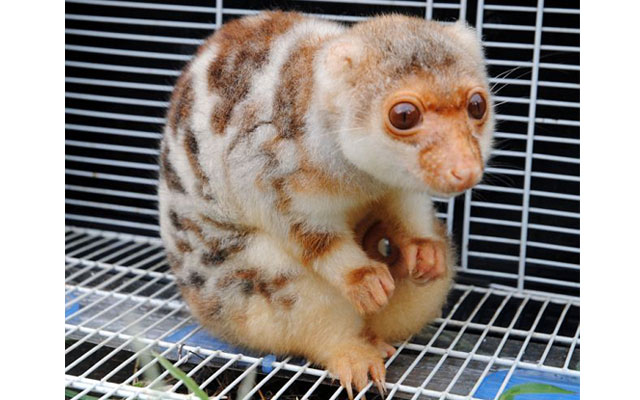
Common spotted cuscus, or Spotted phalanger, or Short-tailed spotted cuscus (Spilocuscus maculatus)
Phylum —chordata
Class — mammalia
Order — diprotodontia
Family — phalangeridae
Genus—spilocuscus
Appearance
The Common spotted cuscus is about the size of a common house cat, weighing 1.5 to 6 kilograms (3.3 to 13.2 lb), body size about 35 to 65 centimeters (14 to 26 in) long, and a tail 32 to 60 centimeters (13 to 24 in) long. It has a round head, small hidden ears, thick fur, and a prehensile tail to aid in climbing. Its eyes range in color from yellows and oranges to reds, and are slit much like a snake's. All four of its limbs have five digits and strong, curved claws, except the first digit on each foot.
It has thick, woolly fur of varying colors depending on age, sex, and location. Males are typically grey/white or brown/white with splotchy patterns on their back and a white underbelly. Only males have spots. Females are usually white or grey and unspotted. Some completely white individuals are known in both males and females. As the young grow, they go through a series of color changes before reaching sexual maturity around one-year-old. Coloration varies from reds and whites to buffs, browns, light greys, and blacks.
The curled, prehensile tail is a distinctive characteristic of the Common spotted cuscus. The upper part of the tail closest to the body is covered in fur, while the lower half is covered in rough scales on the inside surface to grip branches.
Habitat
The main portion of the Common spotted cuscus range occurs in New Guinea (comprised of Indonesia and Papua New Guinea) and the Cape York Peninsula of Australia, a tropical region in the northeastern portion of Australia. The Common spotted cuscus is endemic to both New Guinea and Australia.
Behavior
The Common spotted cuscus is typically very shy, so it is rarely seen, especially in northern Australia. It is nocturnal, hunting and feeding at night and sleeping during the day on self-made platforms in tree branches. It also has been found resting in tree hollows, under tree roots, or among rocks. It is slow-moving and somewhat sluggish, sometimes mistaken for sloths, other possums, or even monkeys.
The Common spotted cuscus is typically a solitary creature, feeding and nesting alone. Interactions with others, especially between competing males, can be aggressive and confrontational. Male cuscuses scent mark their territory to warn off other males, emitting a penetrating musk odor both from their bodies and scent gland excretions. They distribute saliva on branches and twigs of trees to inform others of their territory and mediate social interactions. If they encounter another male in their area, they make barking, snarling, and hissing noises, and stand upright to defend their territories. They are aggressive, and can scratch, bite, and kick potential predators.
Diet
The Common spotted cuscus has an unspecialized dentition, allowing it to eat a wide variety of plant products. It eats the leaves of ficus, alstonia, and slonea plants, nectar, and the fruits of ficus, lithocarpus, aglia, and possibly mischocarpus and pometia plants. It is also known to eat flowers, small animals, and occasionally eggs.
Reproduction
Cuscuses mate year-round and with multiple partners, conducting courtship on tree limbs. The gestation period for a pregnant female is around 13 days, with a pouch period of 6–7 months. While females have four teats in their pouches and can have up to three young per birth, they rarely suckle more than two. Each young weighs no more than 1 gram at birth, and is held in the mother's well-developed forward-opening pouch. Cuscuses can live to be 11 years old, and reach sexual maturity around one-year-old.
In captivity
Cuscuses are very fond of gnawing rotten snags, branches, and picking out insects with their tongues. Therefore, you can place suitable snags from the forest in the aviary. You can also make a wooden block with channels that are filled with honey or insects, so that the animals have an interesting occupation.
The best aviary type is "Night forest".
The daily diet includes insects, pollen, honey, and fruit. Feed is spread out not only in feeders, but also on branches.
 Russian
Russian
 English
English
























